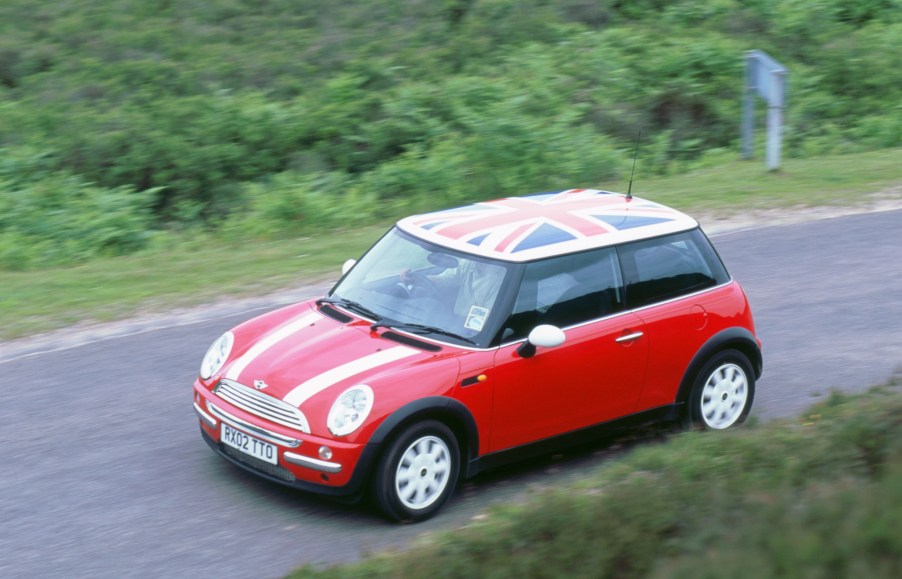
Is a Used 2002-2006 R50 Mini Cooper Reliable?
Used R50 Mini Cooper reliability article highlights:
- A used 2002-2006 R50 Mini Cooper makes a fun, stylish, and economical commuter car, but it has some reliability concerns
- You can avoid most of those concerns, though, with an example that has a Getrag manual and documented radiator, cooling system, and steering pump work
- A well-maintained stick-shift 2005-2006 Mini Cooper can be a reliable car
Although its fuel efficiency is certainly a bonus, the Mini Cooper fanbase also appreciates its design and fun handling. But if you can’t afford a new Mini Cooper, don’t worry, because used ones are noticeably cheaper. And in the case of the original modern model, the R50 Mini Cooper, even smaller and zippier. However, used Minis don’t necessarily have the best reputation for reliability. So, does that mean the R50 is a basket case waiting to happen?
The R50 Mini Cooper has some notable problems

When BMW re-launched the Mini Cooper for the modern era, it took a few years to hit the U.S. We didn’t see the first-gen models, the R50 Hatchback and R56 Cooper S Hatchback, until 2002. But while the latter’s supercharged engine quickly made it an enthusiast favorite, the base Mini has its charms.
Sure, the 115-hp 1.6-liter four-cylinder gives it a 9.6-second 0-60 mph time, but it can keep pace with traffic. It also doesn’t hurt that the R50’s compact size and low weight help it live up to the ‘go-kart handling’ cliché. All this combined with a retro-inspired design—with beer-can exhaust tip—earned the R50 Mini Cooper plenty of fans.
However, as years and miles piled on, several problems emerged. The 2002-2006 Mini has a reputation for transmission and power steering pump failure, for example. The latter was so prevalent that it led to a recall, while the former was the subject of a class-action lawsuit. And these problems are a big reason why 2005 is often considered one of the worst Mini Cooper model years.
Furthermore, these used Mini Coopers are known to develop oil, water pump, and radiator leaks. Head gasket leaks and failures aren’t uncommon, either. Various electrical issues, including ABS and TPMS sensor faults as well as power window motor and regulator failure, are somewhat common, too, Hagerty says. And that’s in addition to regular used car problems such as interior wear and worn suspension parts.
Even the ‘worst’ used R50 Mini Coopers can be reliable with the right transmission and maintenance

But don’t be too quick to dismiss a used R50 Mini Cooper. Although they have some flaws, these cars can be reliable. You just need to keep a few things—as well as features—in mind.
Firstly, those transmission failures require some context. Originally, BMW offered the R50 with two transmissions: a five-speed ‘Midland’ manual and a ZF CVT automatic. The latter is by far the most problematic unit. Remember that class-action lawsuit? It was for this transmission. And reading through reports on CarComplaints, virtually all the 2005 Mini Cooper transmission problems reference the CVT.
Now, the Midland transmission, a leftover from Mini’s original owner Rover, is rather fragile and failure-prone, Classic & Sports Car says. However, in 2005 BMW gave the R50 Mini Cooper a stronger Getrag five-speed manual. So, if you’re shopping for a used first-gen Mini Cooper, get a manual 2005 or 2006 car. If that’s not an option, either budget for more-frequent transmission fluid changes or a Getrag swap.
Secondly, like many other BMW products, the R50 Mini Cooper is prone to radiator and cooling system issues, including age-related expansion tank cracks. However, you can replace the radiator with a stouter version; ditto the other plastic cooling parts. And many owners likely already have.
Yet therein lies another problem. First-gen Minis have a weirdly complicated coolant flushing and bleeding procedure. If you do it wrong, you end up with air in your system, C&SC explains. Add in a leaky radiator and a warp-prone thermostat housing, and you have a recipe for low coolant and poor cooling. Hence the head gasket failures. So, if you’re shopping for a used first-gen Mini Cooper, make sure all these maintenance steps were followed correctly.
As for the water pump leaks, it’s a common maintenance item in virtually all high-mileage cars. The electric power steering pump, meanwhile, isn’t a contradiction. It’s hydraulic steering with an electric pump, not electric power steering. Regardless, there are plenty of more robust replacements available.
Should you buy a 2002-2006 Mini?
There are several other reasons why a used R50 Mini Cooper is worth looking into. For one, its engine has a timing chain, rather than a belt. Also, the 1.6-liter engine doesn’t burn oil like the second-gen Mini’s engine. Plus, the first-gen Mini is lighter and smaller than the second-gen car, which is a boon in the handling department.
It’s worth noting that even with some of the solutions mentioned earlier, the R50 can still develop oil leaks and body rust. The leaks are age-related, though, rather than from a badly-designed part. However, it’s potential problems like these that make pre-purchase inspections so important.
So, is the 2002-2006 Mini Cooper a reliable used car? If you get a stick-shift one, especially a 2005-2006 one, yes. It just requires some careful research and vetting. But if you do it right, you’ll end up with what many already call a modern classic. Not to mention a fun, economical, stylish commuter car that you can find for $5000-$10,000.
Follow more updates from MotorBiscuit on our Facebook page.


